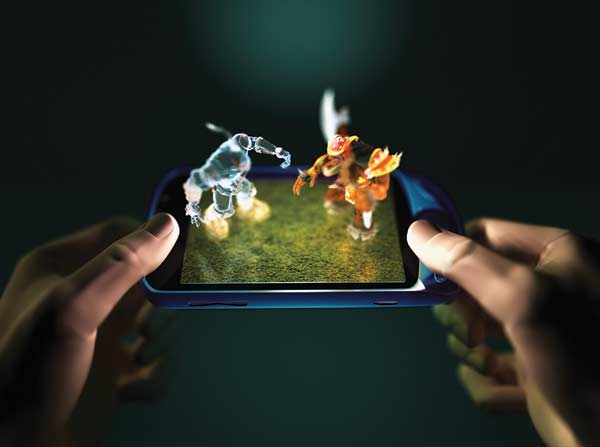[From MIT’s Technology Review; a 3:04 minute video is here]
May/June 2010
TR10: Mobile 3-D
Smart phones will take 3-D mainstream
By Annalee Newitz
This article is part of an annual list of what we believe are the 10 most important emerging technologies. See the full list here.
The Samsung B710 phone looks like a typical smart phone, but something unexpected happens when the screen is moved from a vertical to a horizontal orientation: the image jumps from 2-D to 3-D. The technology that produces this perception of depth is the work of Julien Flack, CTO of Dynamic Digital Depth, who has spent more than a decade perfecting software that can convert 2-D content to 3-D in real time. It could help solve the biggest problem with 3-D: the need for special glasses that deliver a separate image to each eye.
Flack’s software synthesizes 3-D scenes from existing 2-D video by estimating the depth of objects using various cues; a band of sky at the top of a frame probably belongs in the far background, for example. It then creates pairs of slightly different images that the viewer’s brain combines to produce the sensation of depth.
The technology can be used with the much-hyped 3-D televisions announced in January (which require glasses), but its biggest impact will be as a way to create content for mobile devices with autostereoscopic 3-D displays, which work by directing light to deliver different versions of an image directly to each of a viewer’s eyes. The effect works best over a narrow range of viewing angles, so it is ill suited to television or cinema screens. But phones are generally used by one person at a time and are easily held at the optimum angle. That’s why mobile multimedia devices are likely to win the race to bring 3-D into the mainstream.
Powered by Flack’s software, Dynamic Digital Depth has become an early leader in mobile 3-D. The software was built into the B710, which Samsung released in South Korea in 2007, and Samsung has licensed 3-D content generated by Dynamic Digital Depth for its latest 3-D phone, the W960, released in March. Research firm DisplaySearch recently predicted that by 2018 there will be 71 million such devices worldwide.
The most exciting area for Flack right now is games. Hundreds of games actually simulate 3-D spaces internally to handle mechanics such as the path of a missile, and then convert those 3-D spaces into 2-D to display to the player. With his technology, he says, the 3-D geometry “available inside the game itself” can be made accessible to the display. DDD has already released software that converts games to 3-D on PCs and expects to have similar software running on mobile devices in the next year or two.
It’s applications like mobile games and video that will drive the widespread adoption of 3-D screens. And that, in turn, could lay the groundwork for a new generation of surprising interfaces and applications, just as large 2-D screens on mobile devices spawned developments such as touch-based interfaces and augmented reality.
